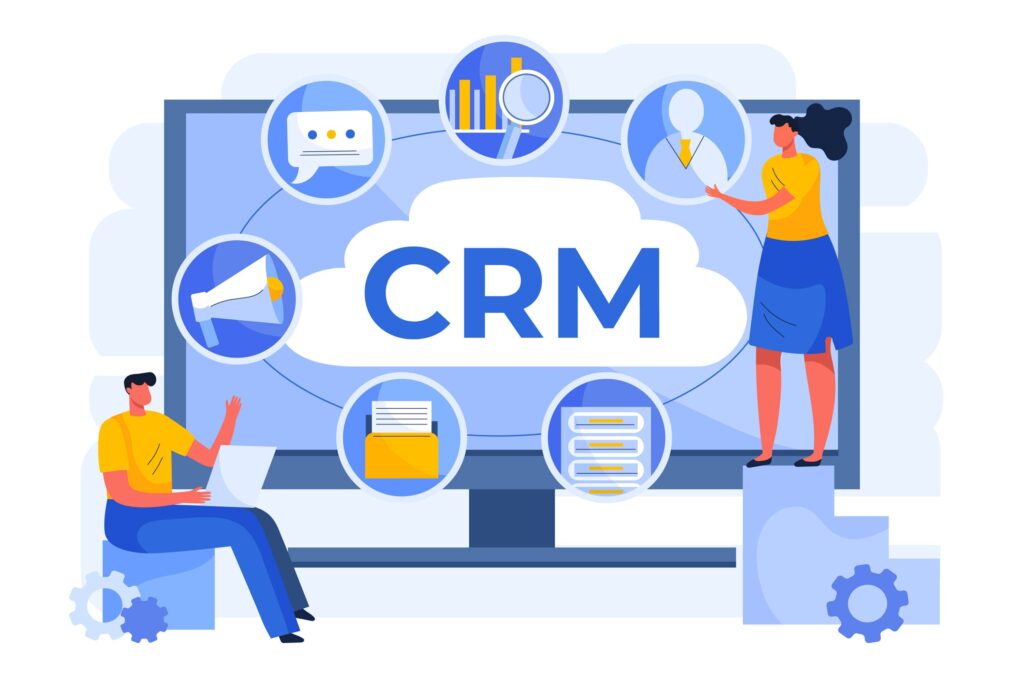Sales Targets for Sales Reps – What They Are and How to Set Them

Every sales rep knows the moment: sitting at the desk, staring at performance charts, and wondering what else can be done to close the quarter strong. This is exactly when clearly defined sales targets and sales goals come into play. They set the rhythm for daily sales activities, guide the sales team through the entire sales cycle, and make it possible to check whether the team’s progress is on track. Without them, sales would be like playing cards without rules—you could count on luck, but predictable results and sales success would be nearly impossible.
For sales managers and sales leaders, targets are more than numbers—they’re benchmarks that align the entire team with broader business goals and business objectives. When companies set sales targets, they not only create accountability but also provide clarity on what the organization expects in terms of revenue goals, market share, and overall business growth.
In this guide, I’ll explain what sales targets are, how to define them correctly, and why setting sales goals is the foundation of effective sales performance. You’ll also see how smart sales goals can be tied to key metrics like average deal size, customer acquisition, and customer satisfaction. Finally, I’ll share practical examples and sales planning strategies you can apply immediately—whether you’re just starting out as one of the many ambitious individual sales reps in today’s sales organizations, or you’re already a seasoned sales professional with hundreds of client meetings behind you.
What Are Sales Targets and Why Are They the Foundation of Effective Sales Performance?
Put simply, sales targets are specific results that an individual sales rep or the entire team is expected to achieve within a set timeframe. They might involve the number of signed contracts, the total value of sales, the number of meetings booked, or even customer satisfaction levels. In short, sales targets turn everyday tasks into measurable outcomes.
Why are they so important? Because without them, there’s no way to evaluate performance, and planning becomes little more than shooting in the dark. Sales targets should be measurable, ambitious, and at the same time realistic—designed to motivate, not frustrate. Well-defined targets serve as a point of reference not only for the individual sales rep but for the entire team, giving everyone a clear sense of direction.
Moreover, sales targets should always be aligned with the broader business strategy. If the company is planning expansion into new markets, the role of the sales rep isn’t just to increase revenue, but also to acquire potential buyers in that new segment or region. In practice, this means that when setting sales targets, reps must take into account not only their own numbers but also the larger organizational context.

Sales Targets vs. Business Goals
It’s easy to confuse the two, but they’re not the same. Sales targets and sales goals focus on the daily activities and results of individual sales reps or the sales team—for example, the number of sales calls made, the number of meetings held, or the number of new clients acquired in a quarter. They are operational, closely tied to day-to-day customer acquisition, and provide clear key metrics for tracking the effectiveness of the sales cycle.
Business goals, on the other hand, represent the broader picture. They reflect organizational business objectives such as entering new markets, expanding into new regions, increasing market share, or improving margins. Business goals are typically linked to financial outcomes like revenue growth, total revenue generated, or specific revenue targets. They also account for external market conditions, competitor activity, and long-term customer retention strategies.
For sales managers and sales leaders, the challenge is translating these high-level business goals into realistic sales targets that motivate the entire team without creating impossible expectations. Well-structured sales goals often take into account factors such as customer acquisition cost, average deal size, or sales cycle length—making it easier to balance ambition with achievability.
In other words, sales targets must always support the execution of business goals—otherwise, they lose their meaning and create a disconnect between day-to-day sales activities and the company’s strategic vision.
Example: If a company is focusing on growth in the renewable energy sector, the sales team shouldn’t concentrate only on existing customers in conventional energy. Instead, they should direct their sales activities toward acquiring new qualified leads, attend the right trade shows, and adjust strategies to meet changing market trends. This way, sales organizations align tactical sales objectives with long-term business growth.
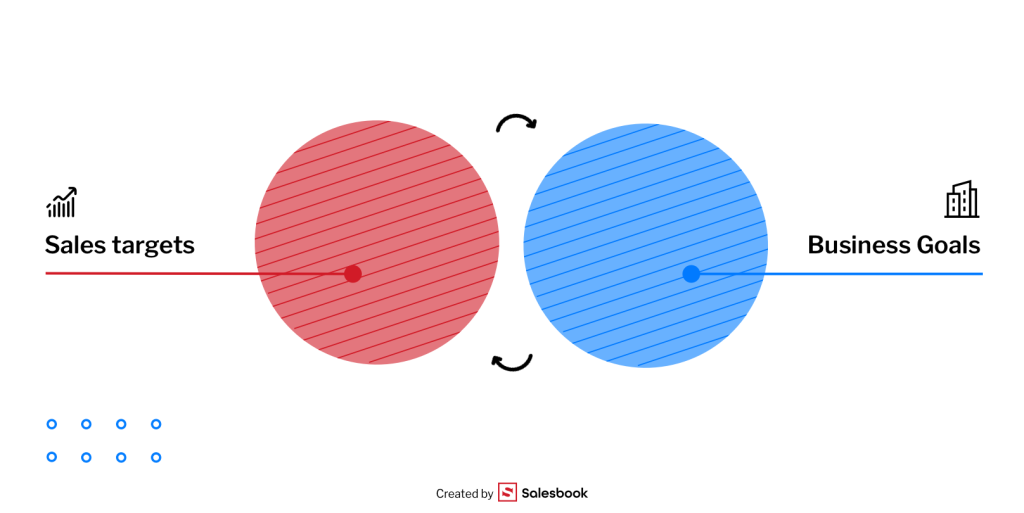
Sales Targets Should Be SMART—but That’s Not Enough
Many newcomers to sales are told that sales targets should be SMART sales goals—specific, measurable, achievable, realistic, and time-bound. This framework works like a compass: it helps set direction, track progress, and evaluate sales performance. SMART goals are particularly valuable for sales managers and sales leaders, because they provide clarity when assigning responsibilities to each team member within a sales team.
However, sales today is about much more than just numbers. True smart sales also involves building relationships, identifying potential buyers, and adjusting activities to shifting market conditions. In practice, that means going beyond the spreadsheet. A sales rep defining their sales objectives shouldn’t only focus on hitting numerical monthly sales goals or annual targets. They need to see how their activities fit into larger business growth strategies, such as customer acquisition, marketing campaigns, or new product launches.
That’s why SMART is only a starting point. The most effective sales organizations combine smart sales goals with flexibility—ensuring that targets adapt to real-time customer needs and market changes while still keeping an eye on long-term revenue goals.
The Classic Approach to Setting Sales Specific Targets
Traditionally, companies set sales targets based on hard data and sales metrics: the number of sales calls made, meetings scheduled, presentations delivered, or contracts signed. These numerical benchmarks serve as the baseline for sales managers to evaluate whether individual sales reps are on track to meet expectations.
In practice, it looks like this:
- Measurable sales goals – e.g., “sign 10 new contracts in a quarter” or “generate 30 qualified leads per month.”
- Time-bound sales targets – every goal must have a clear deadline, otherwise accountability disappears.
- Ongoing monitoring – managers use sales management dashboards and weekly reports to track key performance indicators (KPIs) and ensure the entire team is progressing.
This classic approach provides safety and transparency. Every sales representative knows exactly what’s expected, while sales managers and sales leaders can verify whether the team is aligned with company revenue goals. Even though it’s sometimes seen as rigid, this method remains essential for sales planning, short-term predictability, and keeping the sales cycle under control.

The Modern Approach – Aligning With Company and Sales Rep Development
But today, sales isn’t just about the number of contracts signed. More and more companies emphasize that sales targets should account for rep development, relationship-building, and alignment with long-term strategy.
In this modern approach, instead of focusing only on “hard” numbers like the number of new clients, sales targets may also include:
- Developing sales skills – e.g., learning to work with AI tools or new CRM technologies.
- Active market participation – attending industry events, networking, gathering feedback from potential buyers.
- Close collaboration with marketing – such as testing leads generated from new campaigns.
This perspective allows for far more flexibility. Instead of being confined to spreadsheets, sales reps think bigger: how their work supports the company’s development plans as well as their own professional growth. Managers, in turn, should set sales targets in a hybrid way—combining traditional KPIs with softer objectives that build long-term competitive advantage.
In other words: sales targets must be both effective and meaningful. Reps should feel that their efforts contribute not only to the next quarter’s numbers but also to their successful career path and the company’s overall growth.
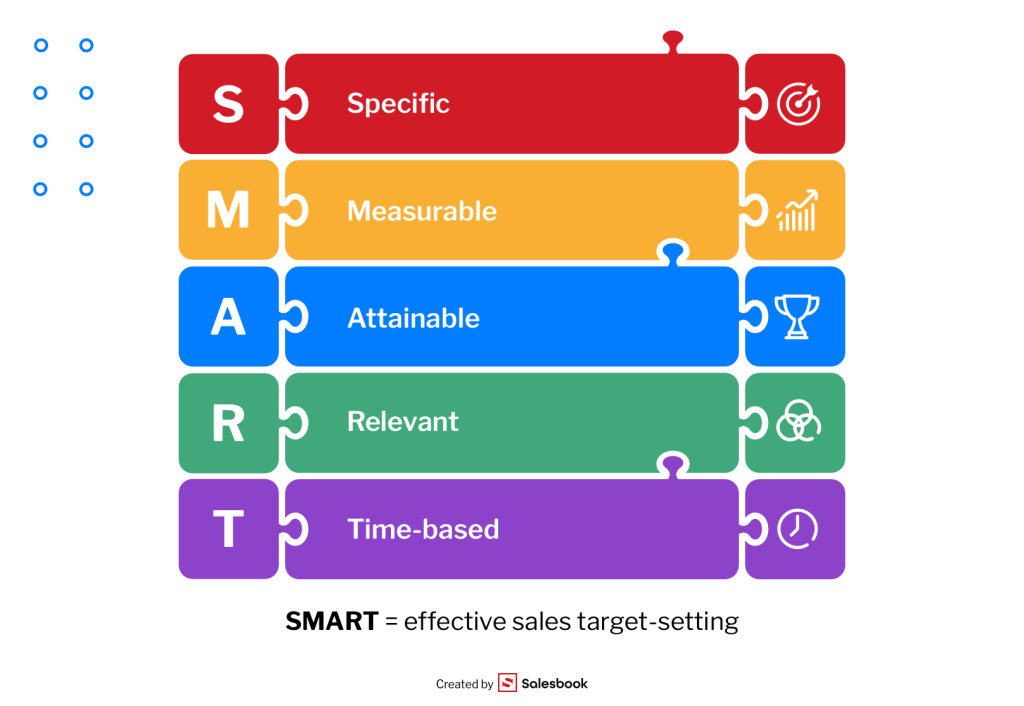
Setting Sales Targets Step by Step
When we think about what sales targets are, it’s tempting to reduce them to a simple equation: “sell more within a given timeframe.” But in practice, it’s much deeper than that. Sales goals based solely on numbers often push reps toward short-term activities that don’t support the company’s long-term business objectives. That’s why effective target-setting requires a structured process: from company vision, through sales planning, down to daily sales activities and sales metrics.
Think of it like drawing a map: first you mark the overall direction, then the checkpoints, and finally the detailed stops along the way. That’s exactly how the process of achieving sales goals works—from the strategic level to the operational level.
For sales managers and sales leaders, this process also means ensuring that sales objectives are realistic in the context of external market conditions, available resources, and past performance of the sales team. For example, if annual targets are set too aggressively without considering the average sales cycle length or customer acquisition rate, the entire team risks burnout and declining motivation. On the other hand, clear specific targets—such as “increase the number of qualified leads by 20% next quarter”—can energize team members and improve overall sales performance.
Translating Business Goals into Individual Sales Targets
Every company has its own business goals: entering new markets, driving revenue growth, or boosting market share. The starting point, therefore, is analysis—where do we want to be as an organization, and what role will the sales team play in getting there? This is where sales managers turn high-level strategies into actionable sales objectives for individual sales reps.
Example:
- The company plans to expand its presence in the B2B sector.
- The sales team receives an action plan that includes acquiring a specific number of new clients within the quarter, aligned with the company’s revenue targets.
- Each team member gets individual tasks—number of meetings, proposals prepared, or participation in trade shows.
In practice, this process requires strong alignment between sales managers, sales leaders, and marketing teams. Defining monthly sales goals for customer acquisition, connecting them with ongoing marketing campaigns, and tracking them with sales analytics ensures that sales targets are not just arbitrary numbers but grounded in strategy.
In other words, when you create sales goals, you always begin with the company’s broader vision, and only then break it down into specific targets for individual reps. That’s how sales organizations ensure that daily work feeds directly into long-term business growth.
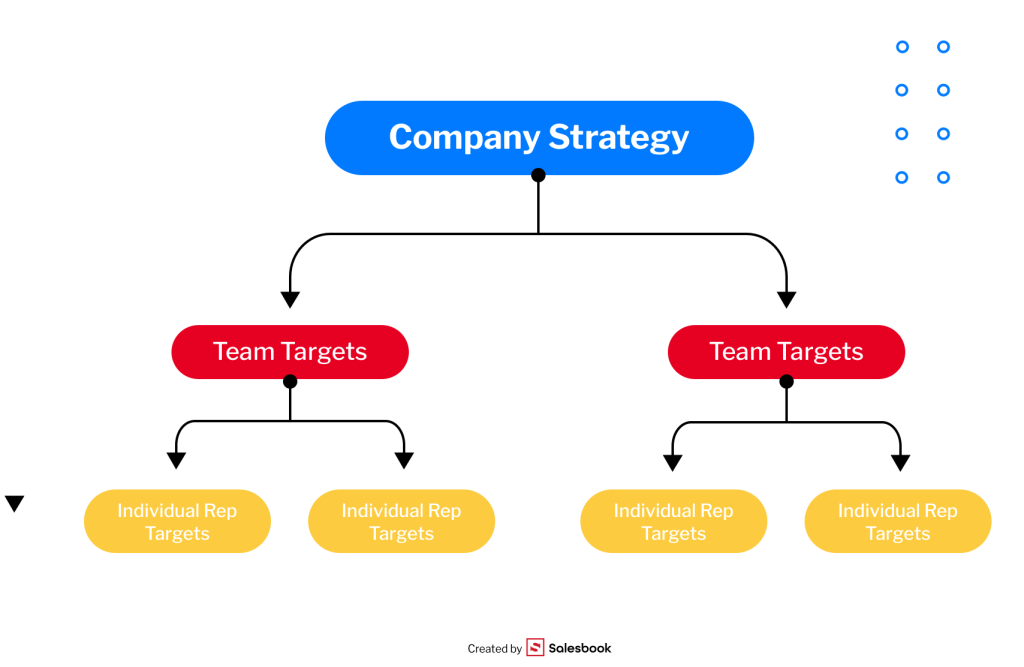
Performance Indicators – From Meetings to Deal Value
To measure progress, it’s not enough to simply say: “we need to improve sales.” We need concrete indicators. Here’s where the difference between quantitative and qualitative sales targets comes in:
- Quantitative targets – e.g., number of phone calls, demo presentations, contracts signed, or total deal value in a given quarter.
- Qualitative targets – e.g., improving customer service processes, increasing client retention, raising customer satisfaction, or building thought leadership through content marketing.
In practice, the best results come from combining both. A company focused only on numbers risks damaging relationships and losing loyal clients. On the other hand, focusing solely on quality may not generate the cash flow needed to keep the business running.
That’s why managers should regularly analyze performance—not just in terms of numbers but also in terms of customer experience. Here, customer relationship management tools (CRMs) are indispensable. They allow you to gather sales data, run detailed analytics, and monitor every stage of the sales process. This makes it easier to respond in real time and, if necessary, adjust KPIs.
The Importance of Understanding Potential Buyers
Even the best-set targets won’t work if a rep doesn’t understand who’s on the other side. That’s why it’s crucial to know potential buyers—their needs, pain points, and buying journey.
Imagine a sales rep who sets sales targets based only on the number of phone calls. Without understanding the audience, those calls are made in a vacuum, and the targets become meaningless. Compare that to a rep using a CRM: they know a client in the energy sector is looking for a specific solution, and that earlier conversations revealed certain objections.
That market knowledge helps refine targets:
- Instead of “make 20 cold calls” → “schedule 5 meetings with decision-makers in sector X.”
- Instead of “generate 10 leads” → “build a list of 10 companies actively investing in our solution with potential for long-term cooperation.”
This precision ensures that achieving sales targets directly contributes to company growth.
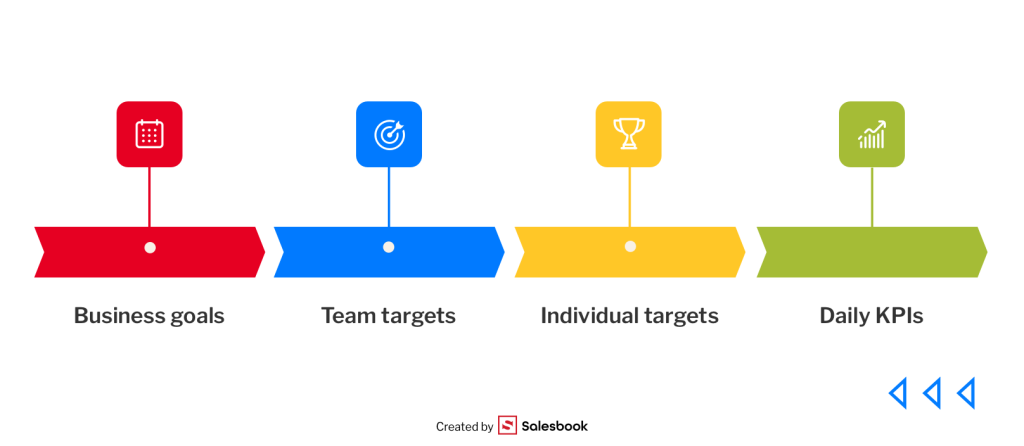
Monitoring Sales Targets – How to Know if You’re on the Right Track
You can have the best-defined sales targets, but if you don’t track progress consistently, even the most ambitious sales goals will quickly lose relevance. In sales, success isn’t only about creating specific targets—it’s about monitoring execution on a daily, weekly, and monthly basis. Think of it like driving a car: the GPS shows the route, but if you don’t look at the screen, you’ll miss your exit.
That’s why monitoring must be systematic and data-driven. Sales managers and sales leaders rely on key performance indicators (KPIs) such as the number of meetings booked, closed deals, or the length of the sales cycle to evaluate whether the sales team is on course. Without these sales metrics, it’s impossible to measure sales performance in a meaningful way.
Modern companies increasingly use sales management dashboards and CRM platforms to visualize the team’s progress against quarterly and annual targets. These dashboards combine pipeline data, conversion rates, and even insights on customer churn or retention rates, giving managers a real-time view of both strengths and risks.
Equally important is context. Monitoring results doesn’t happen in isolation—it has to account for external market conditions and industry shifts. A rep may hit their monthly sales goals, but if the company is losing ground to competitors or struggling with rising customer acquisition cost, adjustments are necessary.
In other words, effective monitoring isn’t about micromanaging—it’s about building a feedback loop that connects sales activities with strategic business objectives. Done right, it ensures that both individual reps and the entire team are aligned, motivated, and always moving closer to long-term sales success.
Tools and Practices for Monitoring Sales Targets
The key to effective monitoring is combining simple routines with modern technology. In practice, this means building habits around reporting while leveraging tools that make it easy to track progress against defined sales goals.
Recurring reports – Daily, weekly, or monthly reviews help both sales reps and managers assess whether the sales team is meeting its revenue goals. These reports don’t just list numbers—they also analyze buyer reactions, the quality of conversations, and obstacles slowing down the sales cycle.
CRM systems and sales analytics – A CRM platform is no longer just a contact database. It’s a source of real-time sales analytics, allowing reps and sales managers to compare past performance with current activities. This way, teams can identify which sales activities are truly moving deals forward and which are wasting time.
Monitoring key metrics – Beyond counting calls or meetings, key metrics include conversion rates, pipeline velocity, and average deal size. Tracking these gives a much clearer picture of whether the sales team is on track to hit its annual targets.
Context and adaptability – Monitoring also requires looking beyond the numbers. External factors like market shifts, competitor moves, or changes in buyer behavior influence whether sales targets are achievable. By regularly reviewing results, companies can make real-time adjustments to both sales strategy and operational plans.
When combined, these practices create a transparent system where both sales reps and managers can see the team’s progress, anticipate risks, and make timely corrections. Instead of guessing, companies set realistic sales targets grounded in data and aligned with overall business objectives.
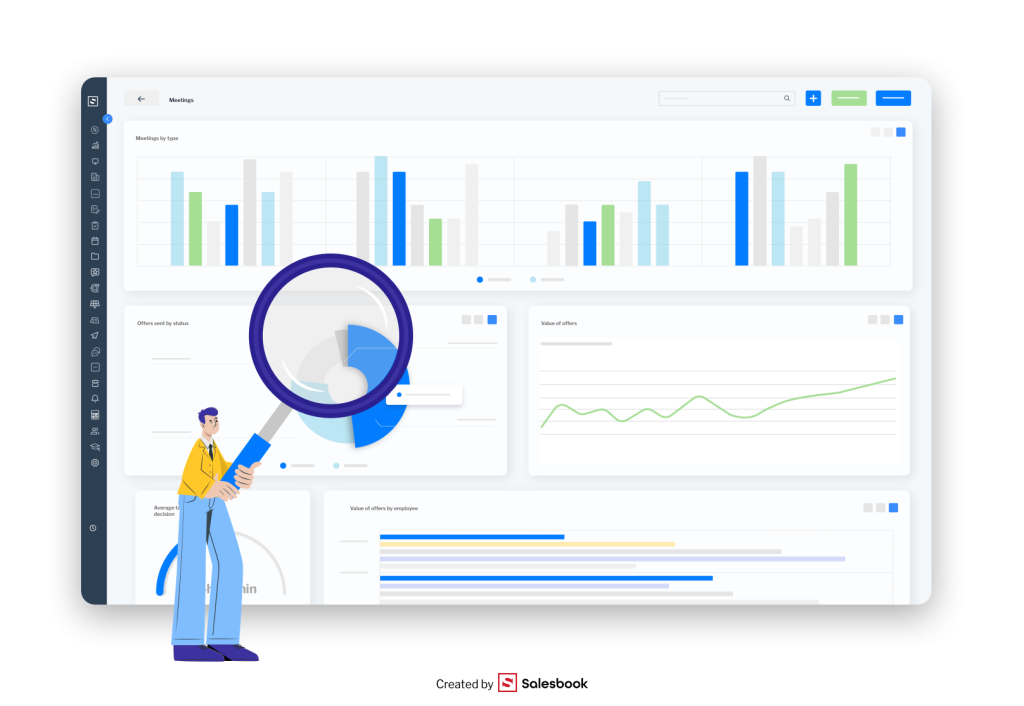
When and How to Adjust the Action Plan
There’s no universal plan that works forever. Even the best-designed sales plans eventually need adjustments. In sales, success depends on reading signals and staying flexible.
Adjustment is necessary when:
- Results show that achieving sales targets has stalled.
- The initial assumptions prove unrealistic—for example, aiming for 100 clients in a market where only 50 companies operate annually.
- The company shifts strategy, focusing on a new product or market.
- External circumstances change—such as an economic crisis, pandemic, or sudden regulatory shift.
How to do it in practice? First, gather the facts. Analyze CRM data, review industry trends, and consult reps working directly with clients. Based on this, you may adjust quotas, shift focus from acquiring new clients to retaining existing clients, or pivot from chasing volume to prioritizing higher margins.
This flexible approach is what drives long-term success. Sales targets should inspire and energize, but also leave room for adjustment when circumstances demand it. After all, what matters isn’t just what you achieve in a set timeframe—but whether you can adapt to market realities and client needs.
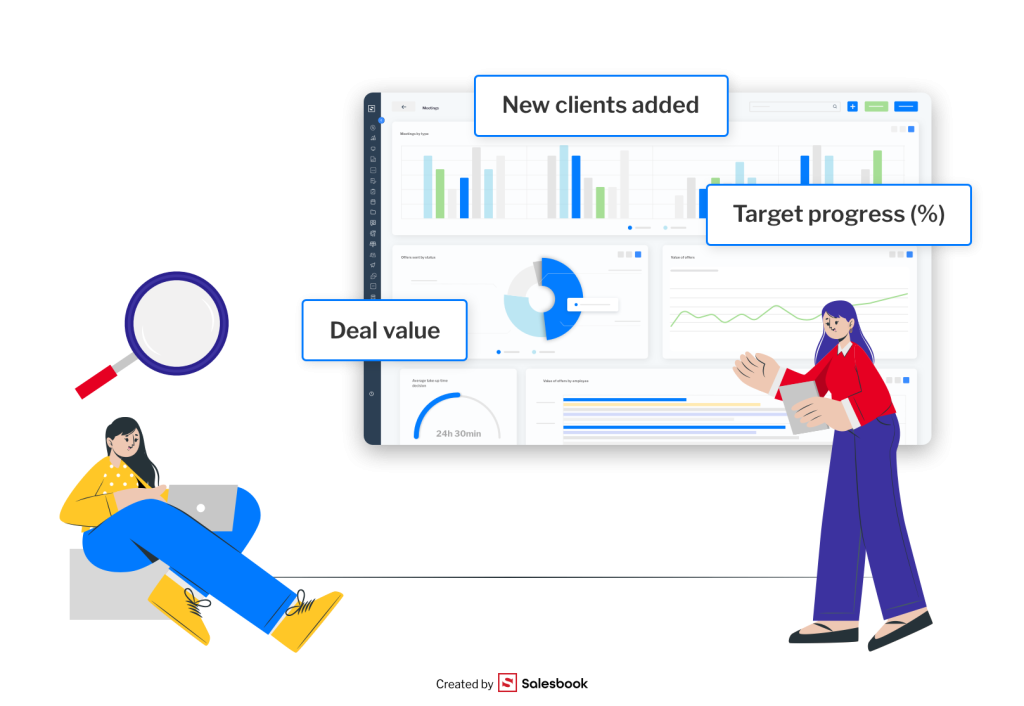
Sales Target Examples – Inspiration for Sales Reps and Managers
Theory alone isn’t enough. To truly understand how setting sales targets works, you need to see it in practice. The examples below will help you not only plan your daily work more effectively but also recognize how diverse sales goals can be. Remember: they’re not just numbers on paper, but real signposts that improve sales performance and drive long-term business growth.
Sample Quantitative and Qualitative Sales Targets
Quantitative targets are the most common because they’re easy to measure and compare. For example:
- Acquiring customers – e.g., bringing in 50 new clients in a quarter.
- Sales revenue – reaching PLN 1 million in annual revenue or in a given half-year.
- Sales meetings – increasing the number of meetings by 20% compared to the previous month.
- Unit sales – boosting sales of product X by 15% year over year.
- Sales quota – ensuring each rep consistently meets or exceeds their monthly or quarterly quota.
- Average order value – raising the average order value by upselling or cross-selling.
- Tracking how much revenue is generated by specific campaigns, regions, or sales reps.
These metrics allow managers to compare past performance with current results and give sales leaders visibility into whether the team is truly reaching sales targets.
Qualitative Sales Targets
But qualitative targets are just as important—they strengthen relationships and build competitive advantage:
- Customer satisfaction – improving feedback scores in post-meeting surveys.
- Customer loyalty – increasing repeat purchases and brand advocacy.
- Customer lifetime – extending the average customer lifetime by ensuring continuous value delivery.
- Reduce customer churn – lowering the percentage of lost accounts compared to the previous year.
- Increase customer lifetime value – focusing on upselling, renewals, and cross-selling to maximize long-term revenue per client.
- Sales materials – raising the quality and personalization of decks, proposals, and demos.
- Marketing collaboration – actively participating in marketing campaigns and ensuring better conversion of marketing-sourced leads into qualified leads.
When setting realistic sales goals, it’s the balance between hard numbers and service quality that delivers true sales success. Quantitative targets keep the sales team focused on financial outcomes, while qualitative ones ensure sustainable relationships with customers—driving both short-term wins and long-term growth.
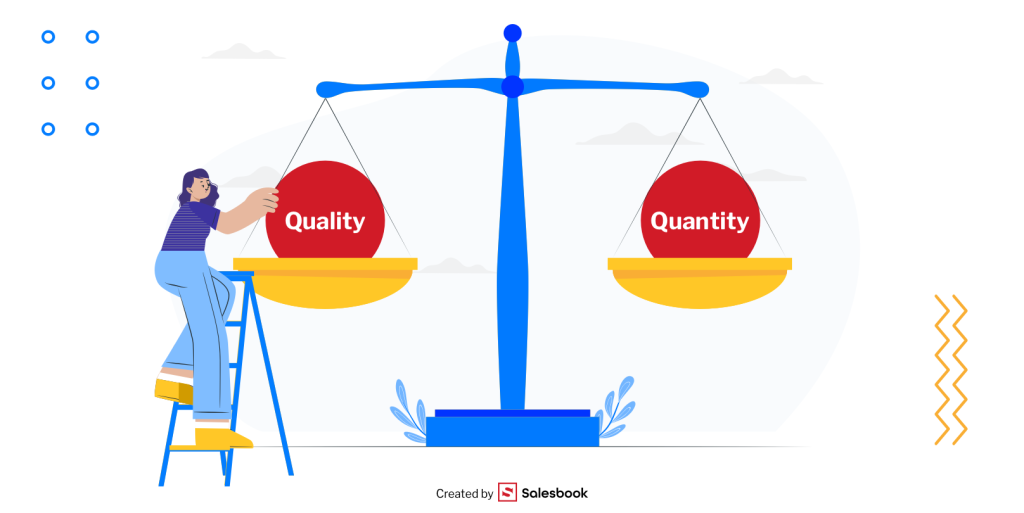
Short-Term vs. Long-Term Targets
Short-term targets are like a sprint—they quickly show whether you’re heading in the right direction. For example:
- “schedule 10 meetings this month,”
- “grow the lead database by 100 contacts within 30 days,”
- “win 5 new clients this quarter.”
Long-term targets are more like a marathon—they require more patience and strategy, but they set the direction for the entire organization:
- “increase market share by 5% within two years,”
- “develop sales in a new segment and acquire 200 clients within three years,”
- “build the rep’s expert brand in the industry and expand the network internationally.”
This way, managers can set sales targets that both motivate day-to-day action and support the company’s long-term vision.
Individual vs. Team Targets
Individual targets focus on a single rep’s results. For example:
- “sell 20 premium packages in a quarter,”
- “achieve an average deal size of over PLN 10,000,”
- “acquire 15 new clients in a year.”
Team targets build a sense of shared responsibility and alignment. For example:
- “achieve PLN 5 million in revenue together within six months,”
- “win 100 new contracts as a team per year,”
- “increase conversion from marketing-sourced leads by 20%.”
In practice, the best companies combine both approaches. Everyone knows what to do individually—and how their contribution impacts the organization’s overall sales targets.
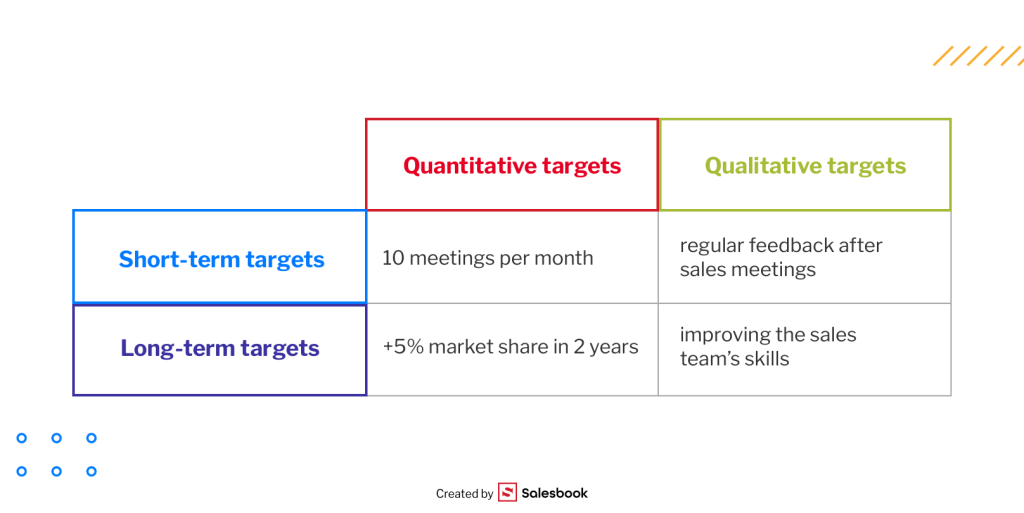
How to Align Sales Targets with a Rep’s Development Plan
Top performers know sales isn’t just numbers in a spreadsheet. It’s also a development process—for both the company and the salesperson. That’s why sales targets should account not only for the next quarter’s outcome but also for the competencies a rep is building and the relationships they’re nurturing.
When defining sales targets, remember they aren’t just “boxes to check.” They also shape a career path and strengthen professional positioning. Ultimately, how you approach setting sales targets will affect not only your company’s results but also your long-term future in sales.
Skill Development as Part of the Sales Strategy
Sales is changing faster than ever. New tools, technologies, and customer expectations keep emerging. That’s why it makes sense to include a development element when setting sales targets.
Examples:
- mastering a new CRM that streamlines daily work,
- learning to use AI for lead analysis or running marketing campaigns,
- developing negotiation and storytelling skills.
This way, targets aren’t just “dry numbers.” They become realistic goals that genuinely help the rep perform better and hit results faster. And in specific cases—when a rep is struggling—targets can be adjusted so they don’t turn into unrealistic goals destined to frustrate.
This approach also benefits the company: developing salespeople means higher team quality, better performance, and long-term retention of existing customers.

“Soft” Targets – Networking, Customer Service, Personal Brand
Not every target has to be tied to the number of signed contracts. Setting sales targets also includes soft goals that, over time, strongly influence execution and overall sales performance.
Examples of soft targets:
- Networking – attending industry events, building new connections, expanding your relationship network.
- Customer service – ensuring quality collaboration, building loyalty, and retaining long-term customers.
- Personal brand – publishing expert articles, joining panel discussions, staying active on social media.
These elements often determine whether a client stays with you for the long haul. You can’t evaluate target achievement purely by sales charts—trust and reputation matter, too.
That’s why managers, when setting sales targets, should take a broader view. A rep who actively engages in the industry, cares for long-term clients, and builds an expert brand delivers far greater value over time than someone focused only on short-term numbers.
Ultimately, combining hard and soft targets—grounded in real events and monitored in a modern CRM—makes sales stable, flexible, and truly effective.
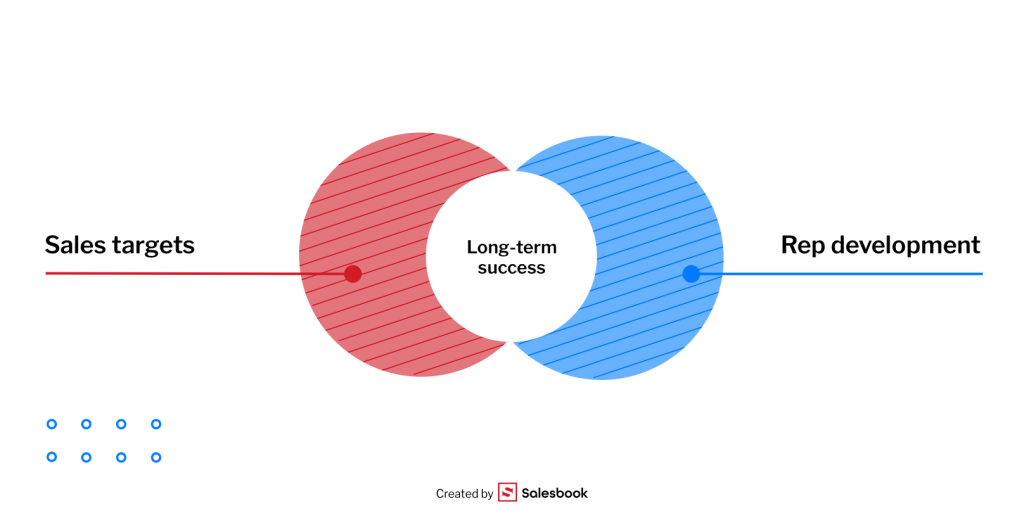
The Most Common Mistakes in Setting Sales Targets—and How to Avoid Them
Even the best plan can fall apart if you make basic mistakes while setting sales targets. Interestingly, the same pitfalls recur across companies—from small businesses to large enterprises. Below are three common traps to watch out for.
Copying Business Goals Without Individualization
A common temptation for managers is to take company-level goals and paste them directly into the sales team’s scorecards. That’s a shortcut. Business goals must be translated into daily sales work in a way that makes sense for each rep.
Example: If leadership wants to increase revenue by 20%, it doesn’t automatically mean every rep should “sell 20% more.” For one person that may be realistic; for another, completely impossible.
How to avoid this mistake?
- Break business goals down into individual tasks.
- Consider experience, client portfolio, and the specific segment a rep works in.
- Use tools—CRM systems or even advanced AI-powered CRMs help personalize targets based on data, not guesswork.

Lack of Monitoring and Updates
Setting a target is only the beginning. If you don’t track progress, the entire process becomes dormant—like choosing a route and never checking the map.
In practice, this means you need:
- regular meetings and reviews,
- sales-friendly CRMs that automatically track activities, set reminders, and consolidate customer data,
- recurring reports and alerts that flag when something is off.
Many reps miss their potential because targets aren’t adapted to changes—either in customer behavior or in the company’s strategy. Updating targets isn’t optional—it’s essential.
Targets That Are Too Vague or Unrealistic
“Sell more” or “get more clients” aren’t targets—they’re wishes. Setting the bar too high has a similar effect. Unrealistic goals don’t motivate; they lower morale and cause burnout.
The fix?
- Set precise, data-based targets—e.g., “win 10 new contracts this quarter.”
- Rely on facts—CRM sales analysis shows what volume of deals, touches, or leads is actually achievable.
- In specific contexts (e.g., CRMs for multi-line agencies), differentiate targets by product portfolio or the complexity of the sales process.
This turns targets into truly useful tools—and makes achieving them possible.
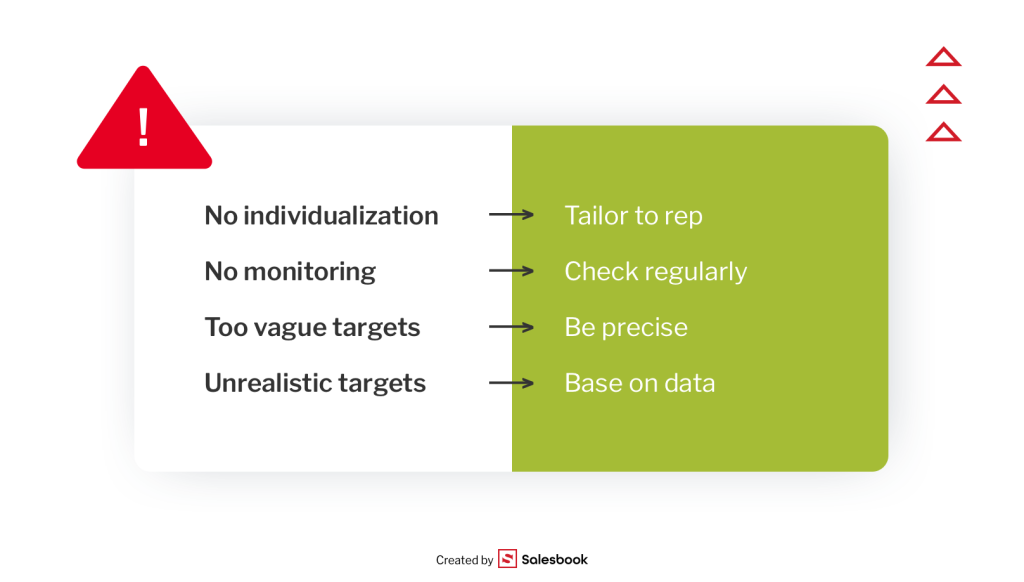
Summary – How Sales Targets Support Company and Rep Growth
Well-planned targets are more than numbers in a table. They’re the foundation of the entire sales target-setting process—the bridge that translates company vision into the daily actions of sales reps.
In defined sales targets, the key is precise alignment with market realities and team capacity. Only then do they become truly realistic targets that motivate action while supporting company growth. Example: instead of a vague “sell more,” set a concrete target like “increase the number of new clients by 15% this quarter.”
Targets also help build and enforce sales plans—they show where we are today and where we’re heading. Monitoring becomes much easier with modern CRMs, which let you track every step, from the first contact to the signed contract.
In short: well-designed targets not only organize daily work—they make long-term success easier to achieve. That’s why it’s worth thinking not only about numbers but also about quality when setting sales targets—they set the rhythm for the entire organization and become a reference point for salespeople’s development.
FAQ – Frequently Asked Questions About Sales Targets
What are sales targets, and how do they differ from quotas?
Sales targets are broader directions and outcomes a rep or team should achieve in a given time—e.g., acquiring 20 new clients per quarter or increasing retention by 10%. Quotas are typically hard, top-down numbers, often without full context. Targets can also include service quality, skill development, and relationship-building.
What are sample sales targets for a beginner?
For someone just starting, activity-based targets work better than pure outcome targets. For example:
- making 100 phone calls per month,
- scheduling 10 meetings,
- delivering 5 product demos,
- acquiring the first 3 clients.
These build habits and help learn the sales process step by step.
How often should sales targets be reviewed?
Ideally weekly and monthly. Weekly reviews show whether a rep is on track; monthly reports provide a broader view. Larger companies should also run quarterly summaries to evaluate sales targets against the overall business strategy.
Do sales targets always have to be measurable?
Most should be, but not all. Measurable targets—like the number of new contracts or revenue—give a clear reference point. But qualitative goals matter too: improving customer service, developing skills, or building a personal brand. The best approach combines both types.
Table of Contents




